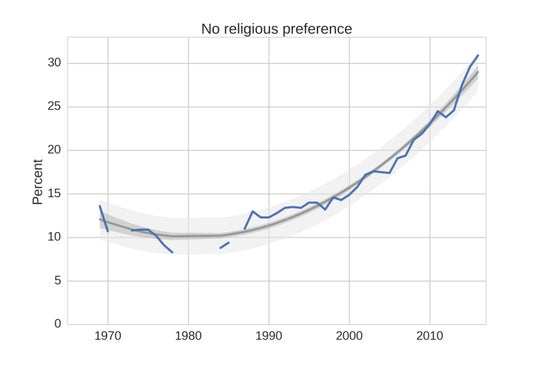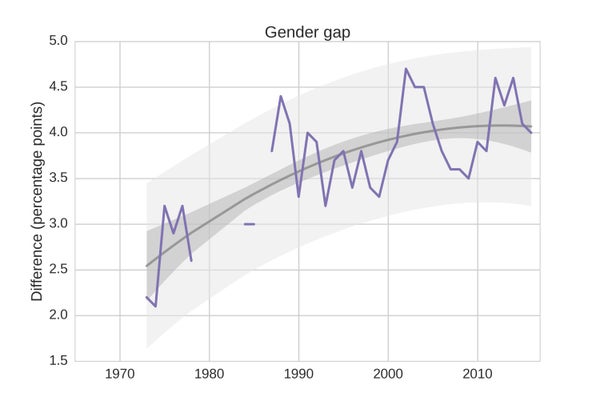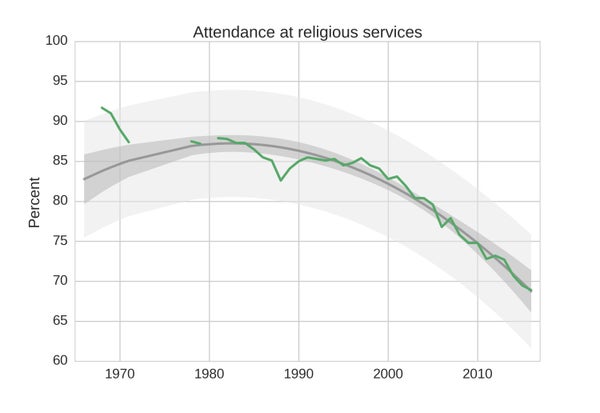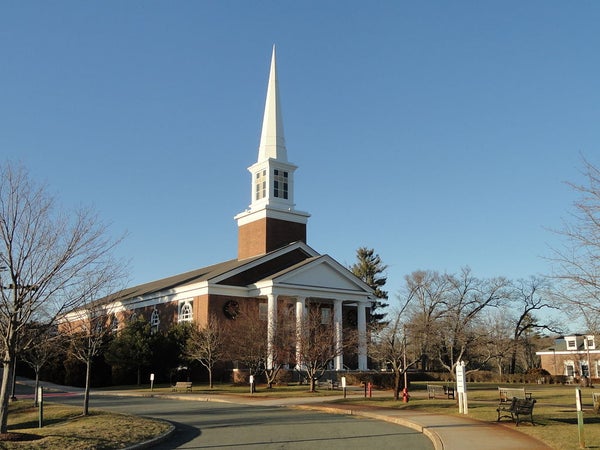This article was published in Scientific American’s former blog network and reflects the views of the author, not necessarily those of Scientific American
The number of college students with no religious affiliation has tripled in the last 30 years, from 10 percent in 1986 to 31 percent in 2016, according to data from the CIRP Freshman Survey. Over the same period, the number who attended religious services dropped from 85 percent to 69 percent. These trends provide a shapshot of the current generation of young adults; they also provide a preview of rapid secularization in the U.S. over the next 30 years.
Since 1966 the Cooperative Institutional Research Program (CIRP) has surveyed incoming college students about their backgrounds, beliefs, and attitudes, including questions about their religious preference and attendance at religious services. In 2016, they surveyed more than 137,000 first-time students at 184 colleges and universities in the U.S.
Figure 1 shows how the number of students whose religious preference is “None” has changed over time. The retreat from religion starts around 1990 and accelerates, averaging almost 1 percentage point per year.
On supporting science journalism
If you're enjoying this article, consider supporting our award-winning journalism by subscribing. By purchasing a subscription you are helping to ensure the future of impactful stories about the discoveries and ideas shaping our world today.

Credit: Allen Downey
Most of this growth comes at the expense of Catholicism, which dropped from 32 percent to 23 percent, and mainstream Protestant denominations including Baptists (from 17 percent to 7 percent), and Methodists (from 9 percent to 3 percent). At the same time the number of students choosing “Other Christian” increased from 5 percent to 13 percent.
The fraction of “Nones” is higher at universities, 36 percent, than at four-year colleges, 26 percent, mostly because more colleges than universities are religiously affiliated. Not surprisingly, religious colleges are more religious, with only 17 percent Nones; and historically black colleges even more so, with 11 percent Nones.
Starting in 2015, the CIRP survey includes “Agnostic” and “Atheist” in the list of religious preferences, along with “None.” For consistency with past data, Figure 1 shows the total of these categories. In 2016, the breakdown of students with no religious affiliation is 8.5 percent Agnostic, 6.4 percent Atheist, and 16 percent None, with all three categories up slightly since 2015.
Men are more likely than women to identify as Agnostic (10 percent versus 8 percent) or Atheist (8 percent versus 5 percent). But it is not clear whether these differences are based on divergent belief or willingness to identify with stigmatized labels like “Atheist."
Overall, more men than women report no religious affiliation, by about 4 percentage points. Figure 2 shows that this gender gap has increased over time, but the rate of growth may be slowing.

Credit: Allen Downey
In their 2015 report, researchers at CIRP break down the Nones by race: Asian students are the most likely to report no affiliation, at 40 percent; Black students are by far the least likely, at 14 percent. Fewer Hispanic students are Nones, at 26 percent, than non-Hispanic Whites, at 30 percent.
Students whose sexual orientation is Lesbian, Gay, Bisexual, Queer, or Other were more than twice as likely to be Atheist, Agnostic, or None, compared to heterosexual students (57 percent versus 27 percent). Many religions have negative attitudes toward homosexuality; apparently the feeling is mutual.
As another indicator of the national retreat from religion, attendance at religious services has decreased sharply since 1990, as shown in Figure 3. Since 1990, the fraction of students reporting that they attend religious services “Frequently” or “Occasionally” has dropped from 85 percent to 69 percent; that is, the number of students skipping services has more than doubled.

Credit: Allen Downey
Almost everyone in this survey is a traditional age college student—98 percent of them are 17-19 years old—so this dataset provides a preview of the next generation of young adults. College students are not a representative sample of the general population, but we can extrapolate.
According to the U.S. Census Bureau, 65 percent of people in the U.S. age 25-24 attended some college, so they could have appeared in the CIRP sample. That leaves 35 percent of the general population unrepresented.
Using data from the General Social Survey, I looked at the relationship between religious affiliation and college attendance (details in this Jupyter notebook). Since 2010, the fraction of Nones has been 4-6 percentage points lower for people who did not attend college.
Combining these results, I estimate that 29 percent of young adults have no religious affiliation,not very different from the college students in the survey, at 31 percent.
This dataset provides a snapshot of students at the beginning of their college experience, but it doesn’t tell us whether people are likely to join a church, or leave one, later in life. In a future article, I will explore lifetime changes in affiliation and belief.
My analysis of data from the CIRP Freshman Survey is in this Jupyter notebook.
Allen Downey is a Professor of Computer Science at Olin College in Needham MA. He is the author of Think Stats, Think Bayes, and other books that use software to explore topics in engineering and data science.
